ANAND CLASSES Study Material and Notes to learn Ohm’s Law, resistance, and types of electrical materials through detailed explanations, solved examples, lab experiments, and real-life applications. Perfect for Class 10 Science students.
🔹 Graph Between V and I (Ohm’s Law)
Q1: What does the graph between potential difference (V) and current (I) show?
A: The graph is a straight line passing through the origin, which shows that current (I) is directly proportional to potential difference (V).
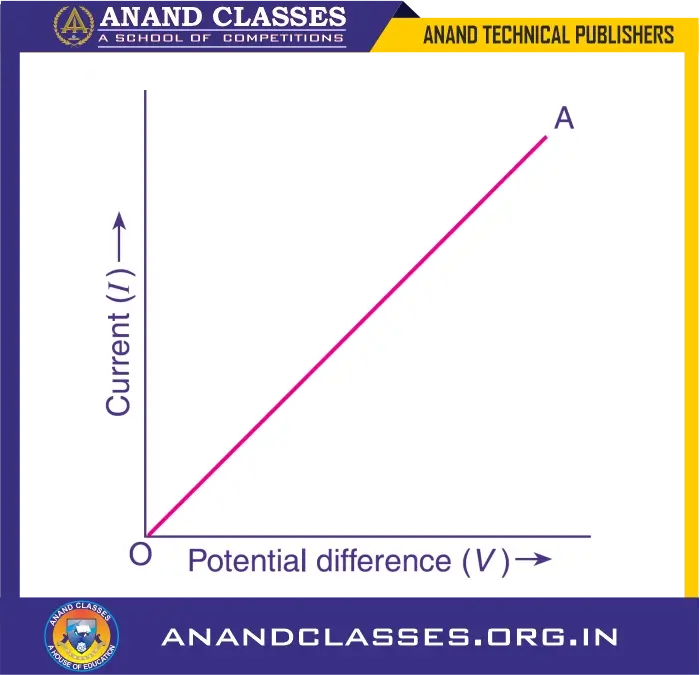
Q2: What conclusion can we draw from the straight-line graph between V and I?
A: The straight-line graph proves Ohm’s Law, which states that $V \propto I$ or V = IR, where R is resistance.
Q3: What is resistance in this context?
A: Resistance is the constant ratio of potential difference to current, i.e., $R = \frac{V}{I}$.
🔹 Sample Problem from the V-I Graph
Q4: The values of current I flowing through a coil for the corresponding values of the potential difference V across the coil are shown below :
Plot a graph between V and I and calculate the resistance of the coil.
A:
| I (A) | 0.05 | 0.10 | 0.20 | 0.30 | 0.40 |
|---|---|---|---|---|---|
| V (Volts) | 0.85 | 1.70 | 3.5 | 5.0 | 6.8 |
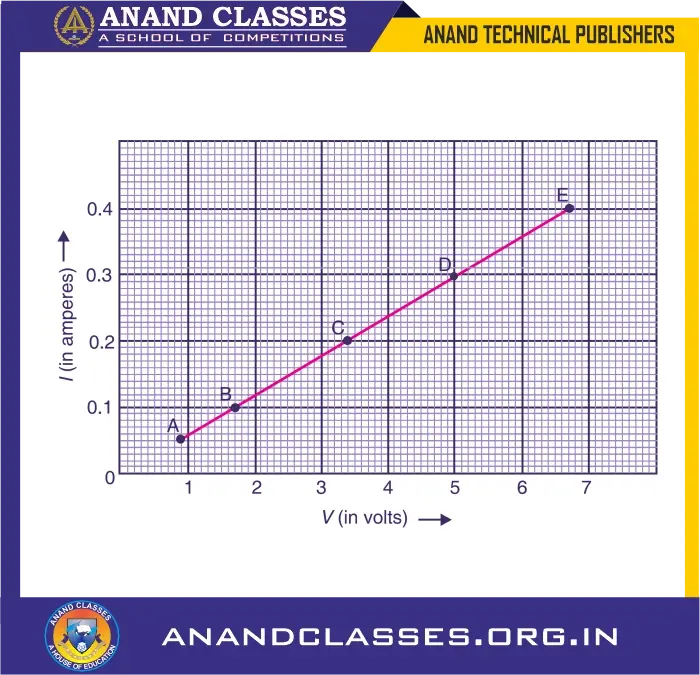
Q5: How do we find resistance of a coil from the above graph?
A: Take any point from the straight-line graph (e.g., Point E : V = 6.8V, I = 0.4 A)
Then, use the formula: $R = \frac{V}{I} = \frac{6.8}{0.4} = 17 \, \Omega$
🔹 Experiment to Verify Ohm’s Law
Q6: How can we verify Ohm’s Law in the lab?
A: By using a circuit consisting of a battery, resistance wire (R), switch, rheostat, ammeter, and voltmeter. We measure different values of current and corresponding potential difference.
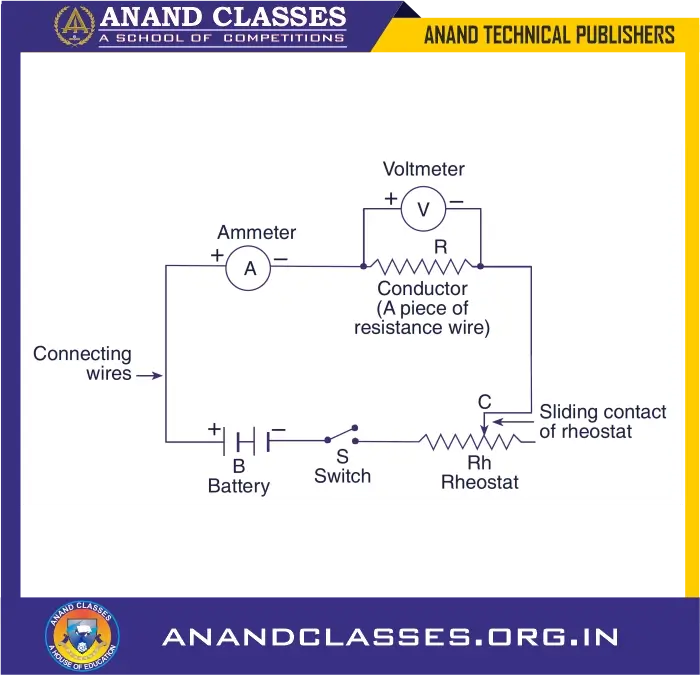
Q7: What setup is used in the experiment to varify Ohm’s Law?
A:
- Battery (B)
- Switch (S)
- Rheostat (Rh)
- Ammeter (A)
- Voltmeter (V)
- Resistance wire (R)
- Connecting wires (as shown in Figure)
Q8: What observations are made during the experiment?
A: For each setting of the rheostat, measure V and I, and compute the ratio $\frac{V}{I}$. If this ratio is constant, Ohm’s Law is verified.
🔹 Good Conductors, Resistors, and Insulators
Q9: What are good conductors?
A: Substances with very low electrical resistance, like copper and aluminium, are called good conductors (See Figure) and are used to make electrical wires.
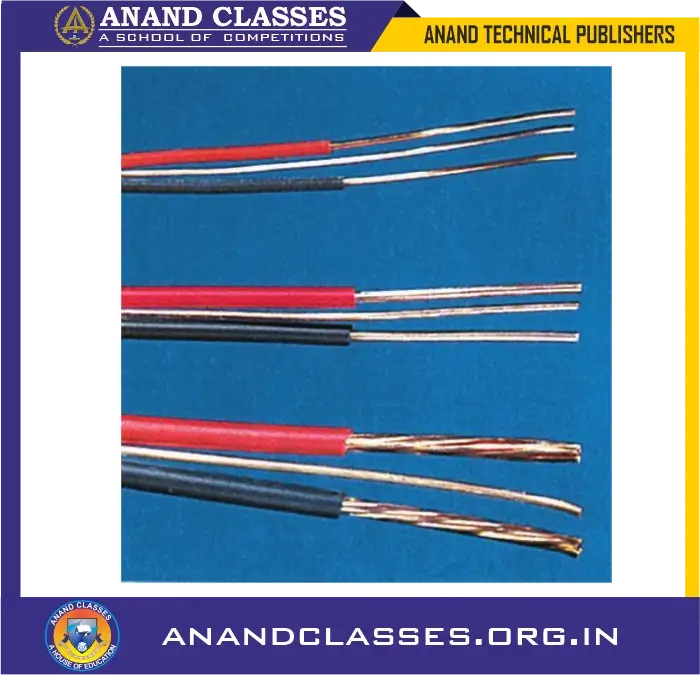
Q10: What are resistors?
A: Substances with comparatively high electrical resistance, such as nichrome, manganin, and constantan, are called resistors.
They reduce current and are used in devices like electric irons (See Figure). Nichrome has high resistance and produces heat when electric current flows through it. It is also a good resistor and doesn’t oxidize easily at high temperatures.
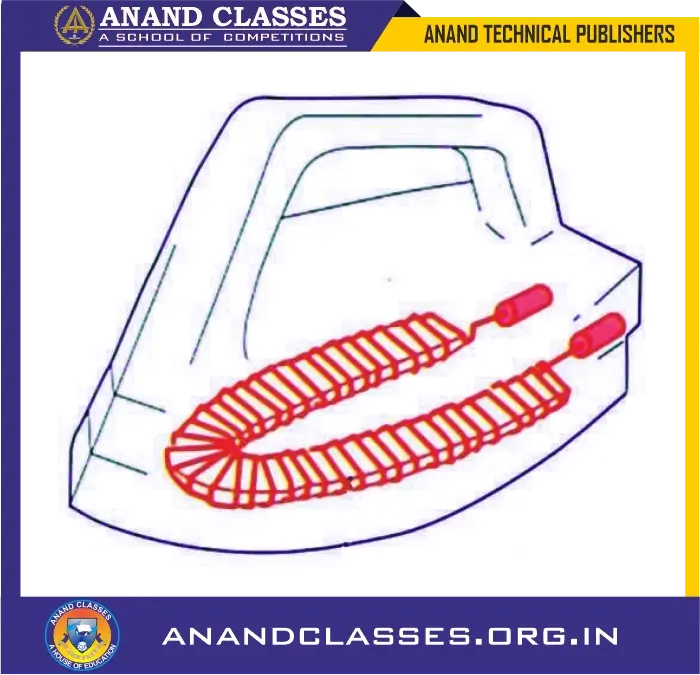
Q11: What are insulators?
A: Substances with infinitely high electrical resistance, like rubber and wood, are insulators. They do not allow electricity to flow. Rubber gloves are used for protection (See Figure).
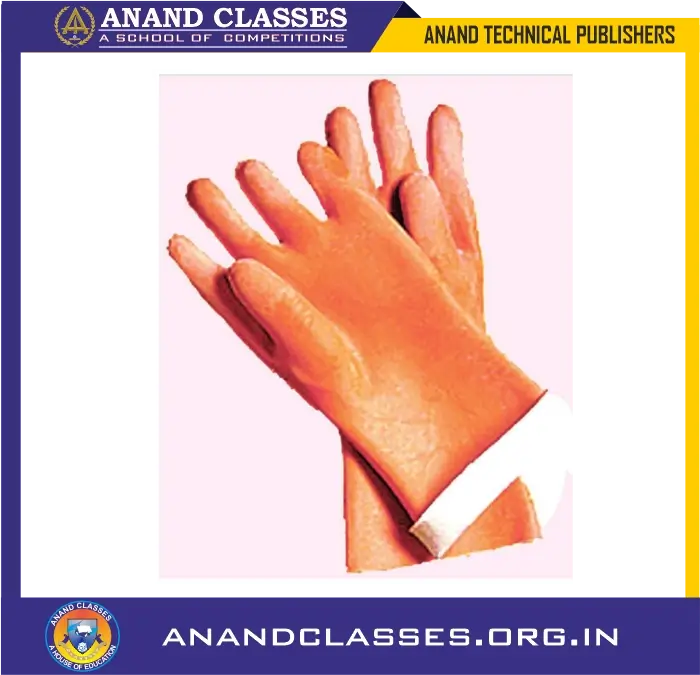
🔍 FAQs: Frequently Asked Questions
Q1. What does Ohm’s Law state?
Ans. Ohm’s Law states that the electric current (I) passing through a conductor is directly proportional to the potential difference (V) across its ends, provided the temperature and other physical conditions remain constant.
Mathematically, V = I x R
Q2. What is the SI unit of resistance?
Ans. The SI unit of resistance is the Ohm (Ω).
Q3. What is meant by good conductors and insulators?
Ans. Good conductors allow electricity to pass through easily (e.g., copper), whereas insulators do not allow electric current to pass through (e.g., rubber).
Q4. How is resistance calculated using a V–I graph?
Ans. The slope of the V–I graph gives the resistance $R = \frac{V}{I}$
Q5. What happens to current if resistance increases while voltage remains constant?
Ans. If resistance increases, the current decreases according to Ohm’s law $I = \frac{V}{R}$.
🧠 Conceptual Questions with Answers
Q1. Why is the V–I graph a straight line for a conductor obeying Ohm’s law?
Ans. It is a straight line because the current is directly proportional to the potential difference, indicating constant resistance.
Q2. If the potential difference is doubled and resistance remains constant, what happens to the current?
Ans. The current will also double, as per $I = \frac{V}{R}$.
Q3. Why are copper and aluminum used to make electrical wires?
Ans. They are good conductors with low resistance, allowing electric current to flow easily.
Q4. A conductor has a resistance of 10 Ω. If 2 A current flows through it, what is the potential difference across it?
Ans. V = IR = $2 \times 10 = 20 \text{ V}$
Q5. What is the effect of temperature on resistance?
Ans. Resistance generally increases with an increase in temperature for metallic conductors.
✅ Multiple Choice Questions (MCQs) with Explanations
Q1. What is the SI unit of current?
A) Volt
B) Ohm
C) Ampere ✔️
D) Coulomb
Explanation: Current is measured in amperes (A).
Q2. A device that opposes the flow of current is called:
A) Conductor
B) Resistor ✔️
C) Battery
D) Capacitor
Explanation: A resistor limits or opposes electric current.
Q3. Which material is a good conductor?
A) Wood
B) Rubber
C) Copper ✔️
D) Glass
Explanation: Copper has low resistance and allows electricity to pass easily.
Q4. According to Ohm’s law, the graph between V and I is:
A) Circular
B) Exponential
C) Straight Line ✔️
D) Parabolic
Explanation: It’s a straight line if resistance is constant.
Q5. Which quantity remains constant in Ohm’s law?
A) Power
B) Resistance ✔️
C) Current
D) Voltage
Explanation: Resistance remains constant if temperature is unchanged.
🔍 Assertion and Reason Based MCQs
Instructions: For the following questions, choose the correct option:
A. Both Assertion and Reason are true, and Reason is the correct explanation of the Assertion.
B. Both Assertion and Reason are true, but Reason is NOT the correct explanation of the Assertion.
C. Assertion is true, but Reason is false.
D. Assertion is false, but Reason is true.
Q1.
Assertion (A): Copper is used in household electric wiring.
Reason (R): Copper is a good conductor of electricity and has low resistance.
✔️ Answer: A
Explanation: Both statements are true, and the reason correctly explains why copper is used.
Q2.
Assertion (A): The graph between current and voltage for an ohmic conductor is a curved line.
Reason (R): In ohmic conductors, current is directly proportional to voltage.
✔️ Answer: C
Explanation: Assertion is false — the graph is a straight line. Reason is true.
Q3.
Assertion (A): The resistance of a conductor remains the same regardless of temperature.
Reason (R): Resistance depends only on the material and length of the conductor.
✔️ Answer: D
Explanation: Assertion is false — resistance changes with temperature. Reason is also incorrect as resistance depends on temperature too.
Q4.
Assertion (A): Insulators do not conduct electricity.
Reason (R): Insulators have a large number of free electrons.
✔️ Answer: C
Explanation: Assertion is true, but reason is false — insulators have very few or no free electrons.
Q5.
Assertion (A): Ohm’s Law is represented by the equation V = IR
Reason (R): Current in a conductor is directly proportional to the voltage across it if resistance remains constant.
✔️ Answer: A
Explanation: Both statements are true and reason explains the assertion.
Q6.
Assertion (A): A thick wire offers more resistance than a thin wire of the same material and length.
Reason (R): Resistance is inversely proportional to the cross-sectional area of the conductor.
✔️ Answer: D
Explanation: Assertion is false — a thick wire offers less resistance. Reason is true.
Q7.
Assertion (A): When resistance increases, current also increases (at constant voltage).
Reason (R): Current is inversely proportional to resistance.
✔️ Answer: D
Explanation: Assertion is false — current decreases when resistance increases. Reason is true.
❗ Do You Know?
- Nichrome is used in heating appliances because of its high resistance.
- Graphs are helpful to visually verify Ohm’s Law.
- Resistance depends on length, area, and material of the conductor.
- Conductors like silver have the least resistance but are expensive.
- Rubber gloves are worn by electricians to prevent electric shocks.
📄 Worksheet: Practice Questions
Q1. Define Ohm’s Law with a neat graph.
Q2. Calculate the resistance if 2.5 A current flows through a resistor at 10 V.
Q3. Identify good conductors and insulators from the following:
Copper, Rubber, Aluminum, Wood, Nichrome.
Q4. Explain the experiment to verify Ohm’s Law using a diagram.
Q5. A current of 0.5 A flows through a resistor of 10 Ω. What is the voltage?
📝 Test Paper (Marks: 20)
Section A: Very Short Answer (1 mark each)
- Define resistance.
- State the SI unit of potential difference.
Section B: Short Answer (2 marks each)
3. State Ohm’s Law with its mathematical expression.
4. List two materials that are used as resistors and why.
Section C: Long Answer (3 marks each)
5. Explain the steps of the experiment to verify Ohm’s Law.
6. A 5 V battery is connected to a 10 Ω resistor. Calculate the current.
7. Plot a V–I graph using the following data and find resistance:
I (A) : 0.1, 0.2, 0.3
V (V) : 1, 2, 3
✨ Important Points for Quick Revision
- Ohm’s Law: V = IR
- Resistance (R) is the opposition to current flow.
- Unit of R: Ohm (Ω), I: Ampere (A), V: Volt (V)
- Good conductors: Copper, aluminum
- Insulators: Rubber, plastic, wood
- Resistors have high resistance and are used to control current.
- V–I graph for Ohmic conductor is a straight line.


